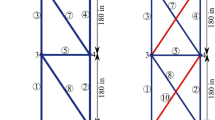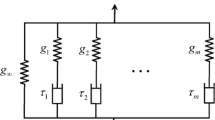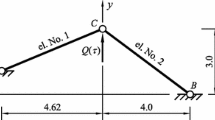Abstract
A study has been performed focusing on the calculation of sensitivities of displacements, velocities, accelerations, and stresses in linear, structural, transient response problems. Several existing sensitivity calculation methods and two new methods are compared for three example problems. All of the methods considered are computationally efficient enough to be suitable for largeorder finite element models. Accordingly, approximation vectors such as vibration mode shapes are used to reduce the dimensionality of the finite element model. Much of the research focused on the convergence of both response quantities and sensitivities as a function of the number of vectors used.
Two types of sensitivity calculation techniques were considered. The first type of technique is an overall finite difference method where the analysis is repeated for perturbed designs. The second type of technique is termed semi-analytical because it involves direct analytical differentiation of the equations of motion with finite difference approximation of the coefficient matrices. To be computationally practical in large-order problems, the overall finite difference methods must use the approximation vectors from the original design in the analyses of the perturbed models. This was found to result in poor convergence of stress sensitivities in several cases. To overcome this poor convergence, two semianalytical techniques were developed. The first technique accounts for the change in eigenvectors through approximate eigenvector derivatives. The second technique applies the mode acceleration method of transient analysis to the sensitivity calculations. Both result in very good convergence of the stress sensitivities. In both techniques the computational cost is much less than would result if the vibration modes were recalculated and then used in an overall finite difference method.
A dot over a symbol indicates derivative with respect to time. A superscriptT indicates a transposed matrix.
Similar content being viewed by others
Abbreviations
- C:
-
system damping matrix
- \(\bar C\) :
-
reduced damping matrix
- C x :
-
cost in number of floating point operations for computational taskx
- E :
-
Youngs's modulus
- f :
-
vector of external forces
- \(\bar f\) :
-
vector of reduced system forces
- g(t) :
-
scalar function representing time dependence of applied loading
- h i :
-
thickness ini-th span or section for five-span beam and stepped beam examples
- K:
-
system stiffness matrix
- \(\bar K\) :
-
reduced stiffness matrix
- l i :
-
distance from beam root to end ofi-th section in stepped beam
- M:
-
system mass matrix
- \(\bar M\) :
-
reduced mass matrix
- M :
-
bending moment
- m :
-
mass design variable in beam example
- N ij :
-
submatrixi, j in matrix series expansion method
- n c :
-
number of critical time points
- n g :
-
number of degrees of freedom in finite element model
- n p :
-
total number of physical response quantities to be calculated as function of time
- n r :
-
number of equations in reduced system
- n t :
-
number of time steps in numerical integration of differential equations
- q:
-
vector of reduced system coordinates
- S:
-
transformation matrix between element stresses and nodal displacements
- t :
-
time
- t c :
-
critical time in critical point constraint
- t iθ :
-
thickness ofθ degree lamina ini-th region of skin for delta wing example
- t iw :
-
thickness of web ini-th region for delta example
- u:
-
vector of displacements
- u i :
-
displacement at one-third point ini-th span of five-span beam example
- u allow :
-
maximum allowable value of displacement
- u tip :
-
deflection at wing or beam tip
- V i :
-
shear force ini-th span
- W ij :
-
submatrixi, j in matrix series expansion method
- x:
-
vector of design variables
- β :
-
semibandwidth (excluding diagonal) of system matrices (e.g. K, M)
- Δt :
-
time step size in matrix series expansion integration technique
- ρ :
-
material density
- σ :
-
vector of elemental stresses
- σ iθ :
-
fiber direction stress inθ degree lamina ini-th region of skin for delta wing example
- σ root :
-
stress at beam root
- τ iw :
-
shear stress ini-th region of web for delta wing example
- Ф :
-
matrix with each column being basis vector
- ω j :
-
j-th vibration frequency
References
Adelman, H.M.; Haftka, R.T. 1986: Sensitivity analysis of discrete structural systems.AIAA J. 24, 823–832
Barthelemy, B.; Chon, C.T.; Haftka, R.T. 1988: Accuracy problems associated with semi-analytical derivatives of static response.Finite Elements in Analysis and Design 4, 249–265
Bathe, K.-J. 1982:Finite element procedures in engineering analysis. Englewood Cliffs: Prentice-Hall
Brenneman, III B. 1973:An analytic solution of systems of linear ordinary differential equations useful for numerical integration. Masters Thesis. Department of Aerospace and Ocean Engineering, Virginia Polytechnic Institute and State University, Blacksburg, VA
Cassis, J.H. 1974: Optimum design of structures subjected to dynamic loads.UCLA-ENG-7451
Cassis, J.H.; Schmit, L.A., Jr. 1976: Optimum structural design with dynamic constraints.J. Struct. Div. ASCE 102, 2053–2071
Craig, R.R., Jr. 1981:Structural dynamics — an introduction to computer methods. John Wiley & Sons
Feng, T.-T.; Arora, J.S.; Haug, E.J., Jr. 1977: Optimal structural design under dynamic loads.Int. J. Num. Meth. Engrg. 11, 35–62
Fleury, C.; Schmit, L.A., Jr. 1980: Dual methods and approximation concepts in structural synthesis.NASA CR 3226
Fox, R.L.; Kapoor, M.P. 1970: Structural optimization in the dynamics regime: a computational approach.AIAA J. 8, 1798–1804
George, J.A.; Liu, J.W. 1981:Computer solution of large sparse positive definite systems. Englewood Cliffs: Prentice-Hall
Grandhi, R.V.; Haftka, R.T.; Watson, L.T. 1986a: Efficient identification of critical stresses in structures subject to dynamic loads.Comp. Struct. 22, 373–386
Grandhi, R.V.; Haftka, R.T.; Watson, L.T. 1986b: Designoriented identification of critical times in transient response.AIAA J. 24, 649–656
Greene, W.H. 1990: Computational aspects of sensitivity calculations in linear transient structural analysis.NASA TM 4156
Greene, W.H.; Haftka, R.T. 1989: Computational aspects of sensitivity calculations in transient structural analysis.Comp. Struct. 32, 433–443
Haftka, R.T.; Adelman, H.M. 1989: Recent developments in structural sensitivity analysis.Struct. Optim. 1, 137–151
Haftka, R.T.; Gürdal, Z.; Kamat, M.P. 1990:Elements of structural optimization, 2nd Edition Dordrecht: Kluwer
Haug, E.J.; Arora, J.S. 1978: Design sensitivity analysis of elastic. mechanical systems.Comp. Methods Appl. Mech. Engrg. 15, 35–62
Haug, E.J.; Wehage, R.; Barman, N.C. 1981: Design sensitivity analysis of planar mechanism and machine dynamics.J. Mech. Design. 103, 560–570
Haug, E.J. 1987: Design sensitivity analysis of dynamic systems. In: Mota Soares, C.A (ed.)Computer aided optimal design: structural and mechanical systems, pp. 705–755. Berlin, Heidelberg, New York: Springer
Hsiao, M.H.; Haug, E.J.; Arora, J.S. 1976: Mechanical design optimization for transient dynamic response.ASME Publication 76-WA/DE-27.
Hsieh, C.C.; Arora, J.S. 1984: Design sensitivity analysis and optimization of dynamic response.Comp. Methods Appl. Mech. Engrg. 43, 195–219
Kahaner, D; Moler, C.; Nash, S. 1989:Numerical methods and software. Englewood Cliffs: Prentice-Hall
Kline, K.A. 1986: Dynamic analysis using a reduced basis of exact modes and Ritz vectors.AIAA J. 24, 2022–2029
Léger, P.; Wilson, E.L. 1988: Modal summation methods for structural dynamic computations.Earthquake Engrg. Struct. Dynamics. 16, 23–27
Melosh, R.J. 1975: Integration of linear equations of motion.J. Struct. Division, ASCE. 101, 1551–1558
Meric, R.A. 1988: Shape design sensitivity analysis of dynamic structures.AIAA J. 26, 206–212
Nelson, R.B. 1976: Simplified calculation of eigenvector derivatives.AIAA J. 14, 1201–1205
Nour-Omid, B.; Clough, R.W. 1984: Dynamic analysis of structures using Lanczos co-ordinates.Earthquake Engrg. Struct. Dynamics. 12, 565–577
Ray, D.; Pister, K.S.; Polak, E. 1978: Sensitivity analysis for hysteretic dynamic systems: theory and applications.Comp. Methods Appl. Mech. Engrg. 14, 179–208
Sandridge, C.A.; Haftka, R.T. 1989: Accuracy of eigenvalue derivatives from reduced order structural models.J. Guidance, Control and Dynamics. 12, 822–829
Schmit, L.A.; Miura, H. 1978: An advanced structural analysis/synthesis capability — ACCESS 2.Int. J. Num. Methods Engrg. 12, 353–377
Sutter, T.R.; Camarda, C.J. Walsh, J.L.; Adelman, H.M. 1988: Comparison of several methods for calculating vibration mode shape derivatives.AIAA J. 26, 1506–1511
Tortorelli, D.A.; Haber, R.B.; Lu, S.C.-Y. 1989: Shape sensitivities for nonlinear dynamic thermoelastic structures.AIAA Paper No. 89-1311. Presented at the 30th AIAA/ASME/ASCE/ AHS/ASC Structures, Structural Dynamics and Materials Conf. (held in Mobile, Alabama)
Vanderplaats, G.N. 1984: An efficient feasible directions algorithm for design synthesis.AIAA J. 22, 1633–1640
Wang, B.P. 1985: An improved approximate method for computing eigenvector derivatives. Paper presented at work in progress session, AIAA/ASME/ASCE/AHS 26th Structures, Structural Dynamics and Materials Conf. (held in Orlando, Florida)
Whetstone, W.D. 1985:EISI-EAL engineering analysis language reference manual - EISI-EAL system level 312. Engineering Information Systems
Williams, D. 1948: Dynamic loads in aeroplanes under given impulsive loads with particular reference to landing and gust loads on a large flying boat.Great Britain Royal Aircraft Establishment, R & M, No.2221
Wilson, E.L.; Yuan, M.-W.; Dickens, J.M. 1982: Dynamic analysis by direct superposition of Ritz vectors.Earthquake Engrg. Struct. Dynamics 10, 813–821
Author information
Authors and Affiliations
Rights and permissions
About this article
Cite this article
Greene, W.H., Haftka, R.T. Computational aspects of sensitivity calculations in linear transient structural analysis. Structural Optimization 3, 176–201 (1991). https://doi.org/10.1007/BF01743074
Received:
Issue Date:
DOI: https://doi.org/10.1007/BF01743074




